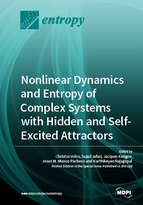Nonlinear Dynamics and Entropy of Complex Systems with Hidden and Self-excited Attractors
A special issue of Entropy (ISSN 1099-4300). This special issue belongs to the section "Complexity".
Deadline for manuscript submissions: closed (31 January 2019) | Viewed by 79564
Special Issue Editors
Interests: electrical and electronics engineering; mathematical modeling; control theory; engineering, applied and computational mathematics; numerical analysis; mathematical analysis; numerical modeling; modeling and simulation; robotics
Special Issues, Collections and Topics in MDPI journals
Interests: chaos; nonlinear dynamics; optimization
Special Issues, Collections and Topics in MDPI journals
Interests: chaos theory; nonlinear phenomena; nonlinear circuits; hidden attractors; synchronization
Special Issues, Collections and Topics in MDPI journals
Interests: fractional order calculus; chaotic systems and their applications; hidden attractors; mathematical modeling; chaos theory; synchronization; random number generators
Special Issues, Collections and Topics in MDPI journals
Interests: optimal control theory; artificial intelligence; adaptive control; neural networks
Special Issues, Collections and Topics in MDPI journals
Special Issue Information
Dear Colleagues,
In the last few years, entropy has been a basic and important concept in information theory. It is also often used as a measure of the degree of chaos in systems, e.g., Lyapunov exponents, fractal dimension, and entropy are usually used to describe the complexity of chaotic systems. Thus, it would be very interesting to study entropy in nonlinear systems. Additionally, there has been an increasing interest in a new classification of nonlinear dynamical systems including two kinds of attractors: Self-excited attractors and hidden attractors. Self-excited attractors can be localized straight forwardly by applying a standard computational procedure. Some interesting examples of systems with self-excited attractors are chaotic systems with different kinds of symmetry, with multi-scroll attractors, with multiple attractors, and with extreme multistability.
In systems with hidden attractors we have to develop a specific computational procedure to identify the hidden attractors due to the fact that the equilibrium points do not help in their localization. Some examples of this kind of systems are chaotic dynamical systems with no equilibrium points, with only stable equilibria, with curves of equilibria, with surfaces of equilibria, and with non-hyperbolic equilibria. There is evidence that hidden attractors play an important role in the various fields ranging from phase-locked loops, oscillators, describing convective fluid motion, model of drilling system, information theory, cryptography to multilevel DC/DC converter. Furthermore, hidden attractors may lead to unexpected and disastrous responses.
The Special Issue is dedicated to the presentation and discussion of the advanced topics of entropy in complex systems with hidden attractors and self-excited attractors. The contribution to the Special Issue should be focus on the aspects of nonlinear dynamics, entropy, and applications of nonlinear systems with hidden and self-excited attractors.
Dr. Christos VolosDr. Sajad Jafari
Dr. Jacques Kengne
Dr. Jesus M. Munoz-Pacheco
Dr. Karthikeyan Rajagopal
Guest Editors
Manuscript Submission Information
Manuscripts should be submitted online at www.mdpi.com by registering and logging in to this website. Once you are registered, click here to go to the submission form. Manuscripts can be submitted until the deadline. All submissions that pass pre-check are peer-reviewed. Accepted papers will be published continuously in the journal (as soon as accepted) and will be listed together on the special issue website. Research articles, review articles as well as short communications are invited. For planned papers, a title and short abstract (about 100 words) can be sent to the Editorial Office for announcement on this website.
Submitted manuscripts should not have been published previously, nor be under consideration for publication elsewhere (except conference proceedings papers). All manuscripts are thoroughly refereed through a single-blind peer-review process. A guide for authors and other relevant information for submission of manuscripts is available on the Instructions for Authors page. Entropy is an international peer-reviewed open access monthly journal published by MDPI.
Please visit the Instructions for Authors page before submitting a manuscript. The Article Processing Charge (APC) for publication in this open access journal is 2600 CHF (Swiss Francs). Submitted papers should be well formatted and use good English. Authors may use MDPI's English editing service prior to publication or during author revisions.
Keywords
- Nonlinear systems
- Complex systems
- Chaos
- Control
- Entropy
- Fractionalorder systems
- Hidden attractors
- Self-excited attractors
- Synchronization









